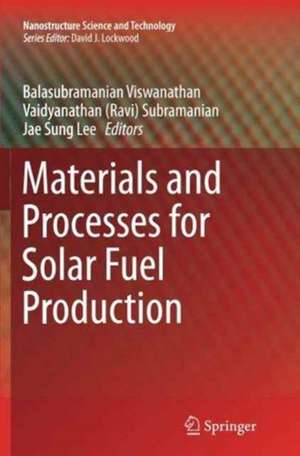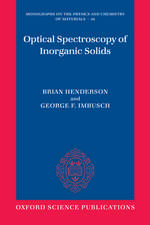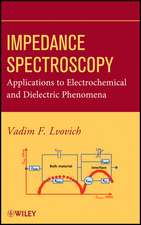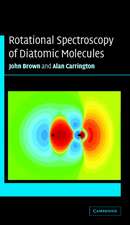Materials and Processes for Solar Fuel Production: Nanostructure Science and Technology, cartea 174
Editat de Balasubramanian Viswanathan, Vaidyanathan (Ravi) Subramanian, Jae Sung Leeen Limba Engleză Paperback – 23 aug 2016
| Toate formatele și edițiile | Preț | Express |
|---|---|---|
| Paperback (1) | 555.89 lei 38-44 zile | |
| Springer – 23 aug 2016 | 555.89 lei 38-44 zile | |
| Hardback (1) | 644.49 lei 43-57 zile | |
| Springer – 10 oct 2014 | 644.49 lei 43-57 zile |
Din seria Nanostructure Science and Technology
- 18%
 Preț: 1114.65 lei
Preț: 1114.65 lei - 18%
 Preț: 1001.02 lei
Preț: 1001.02 lei - 24%
 Preț: 834.57 lei
Preț: 834.57 lei -
 Preț: 405.66 lei
Preț: 405.66 lei -
 Preț: 405.28 lei
Preț: 405.28 lei - 18%
 Preț: 947.35 lei
Preț: 947.35 lei - 18%
 Preț: 734.27 lei
Preț: 734.27 lei - 15%
 Preț: 696.02 lei
Preț: 696.02 lei - 20%
 Preț: 585.29 lei
Preț: 585.29 lei - 20%
 Preț: 556.90 lei
Preț: 556.90 lei - 15%
 Preț: 646.62 lei
Preț: 646.62 lei - 18%
 Preț: 947.50 lei
Preț: 947.50 lei -
 Preț: 397.97 lei
Preț: 397.97 lei -
 Preț: 406.05 lei
Preț: 406.05 lei - 18%
 Preț: 967.08 lei
Preț: 967.08 lei - 18%
 Preț: 947.50 lei
Preț: 947.50 lei - 18%
 Preț: 948.29 lei
Preț: 948.29 lei - 18%
 Preț: 950.03 lei
Preț: 950.03 lei - 18%
 Preț: 951.29 lei
Preț: 951.29 lei - 18%
 Preț: 948.92 lei
Preț: 948.92 lei - 18%
 Preț: 960.13 lei
Preț: 960.13 lei - 19%
 Preț: 559.01 lei
Preț: 559.01 lei - 15%
 Preț: 694.69 lei
Preț: 694.69 lei - 15%
 Preț: 635.15 lei
Preț: 635.15 lei - 15%
 Preț: 640.06 lei
Preț: 640.06 lei - 18%
 Preț: 948.79 lei
Preț: 948.79 lei - 20%
 Preț: 564.27 lei
Preț: 564.27 lei - 20%
 Preț: 628.33 lei
Preț: 628.33 lei - 15%
 Preț: 647.59 lei
Preț: 647.59 lei - 15%
 Preț: 643.16 lei
Preț: 643.16 lei - 15%
 Preț: 643.34 lei
Preț: 643.34 lei - 18%
 Preț: 955.08 lei
Preț: 955.08 lei - 15%
 Preț: 587.72 lei
Preț: 587.72 lei - 15%
 Preț: 649.87 lei
Preț: 649.87 lei - 15%
 Preț: 646.43 lei
Preț: 646.43 lei -
 Preț: 388.72 lei
Preț: 388.72 lei - 18%
 Preț: 955.25 lei
Preț: 955.25 lei - 5%
 Preț: 716.75 lei
Preț: 716.75 lei - 18%
 Preț: 952.89 lei
Preț: 952.89 lei - 18%
 Preț: 1258.46 lei
Preț: 1258.46 lei
Preț: 555.89 lei
Preț vechi: 694.87 lei
-20% Nou
Puncte Express: 834
Preț estimativ în valută:
106.37€ • 111.36$ • 88.01£
106.37€ • 111.36$ • 88.01£
Carte tipărită la comandă
Livrare economică 02-08 aprilie
Preluare comenzi: 021 569.72.76
Specificații
ISBN-13: 9781493945702
ISBN-10: 149394570X
Pagini: 237
Ilustrații: XII, 237 p. 147 illus., 107 illus. in color.
Dimensiuni: 155 x 235 mm
Ediția:Softcover reprint of the original 1st ed. 2014
Editura: Springer
Colecția Springer
Seria Nanostructure Science and Technology
Locul publicării:New York, NY, United States
ISBN-10: 149394570X
Pagini: 237
Ilustrații: XII, 237 p. 147 illus., 107 illus. in color.
Dimensiuni: 155 x 235 mm
Ediția:Softcover reprint of the original 1st ed. 2014
Editura: Springer
Colecția Springer
Seria Nanostructure Science and Technology
Locul publicării:New York, NY, United States
Cuprins
Strategic Design of Heterojunction CdS Photocatalysts for Solar Hydrogen.- Encapsulation for improving the efficiencies of solar cells .- Photocatalytic Solar Hydrogen Production: Current Status and Future Challenges.- Electrochemical and optical characterization of materials band structure.- New p-type Semiconducting Metal Oxides for Solar-to-Fuel Conversion: Investigation and Challenges.- Theoretical modeling of photoelectrochemistry related oxide-photocatalysts.- Photo-fuel cells. An alternative route for solar energy conversion.- Simultaneous Photodegradation and Hydrogen Production With TiO2/Pt/CdS Using UV-visible Light in the Presence of a Sacrificial Agent and a Pollutant.- Stability of the β-Bi2O3 Nanoporous Photoanodes for Solar Water Splitting.- Passivating the Surface of TiO2 Photoelectrodes with Nb2O5 and Al2O3 for High-efficiency Dye-Sensitized Solar Cells.- Reduction of Carbon dioxide- Photo-catalytic Route to Solar Fuels.
Notă biografică
Vaidyanathan Subramanian is Associate Professor of Chemical Engineering at the University of Nevada, Reno. He is an adjunct in the Chemistry Department. He is also the Solar Energy thrust area coordinator in the Renewable Energy Center at the University. Prof. Subramanians’ research focus is on nanostructured materials for solar energy utilization and fuel cells. His primary interest is in the development of materials for photovoltaics, fuel cells, clean fuel production, and environmental remediation. In his 14 years of research he has developed inorganic materials including semiconductor-semiconductor and semiconductor-metal nanocomposites for applications related to solar energy utilization and fuel cells. He has received several awards as a student (AIChE Poster Award, Catalysis Club Award, and Best Thesis Award) and as a faculty (Japanese Society for Promotion of Science Fellowship - JSPS). Prof. Subramanian has received research grants and contracts from federal agencies such as the National Science Foundation, the Department of Defense (DARPA), the Department of Energy, as well as from industrial partners.
Balasubramanian Viswanathan had been a faculty in the Department of Chemistry, Indian Institute of Technology, Chennai (Madras) and since 2006 he is heading the National Centre for Catalysis Research in the same institute. He is a renowned Scientist and a distinguished teacher. His research contributions are enormous in the fields of Heterogeneous Catalysis, Materials Science, Theoretical Chemistry and Energy. He has published over 500 peer-reviewed journal articles and authored more than 25 books and some of these publications including titles like Chemical and Electrochemical Energy Systems and Fuel cells and won several awards and number of fellowships at both national and international levels.
Jae Sung Lee is a professor of Energy and Chemical Engineering at Ulsan National Institute of Science &Technology (UNIST) in Ulsan, Korea. Combined with his former tenure at Pohang University of Science & Technology (POSTECH), he has 30 years of experience in teaching and research in catalysis and energy technologies. He obtained his PhD in Chemical Engineering from Stanford University, MSc from KAIST, and B.S from Seoul National University. He worked for Catalytica as a research fellow (‘84-‘86), and was a visiting
professor to Yale University (‘93-‘94). His current research projects include photocatalytic water splitting for solar fuels, electrocatalysis for low temperature fuel cells, and catalysis for energy and environment He has published more than 300 scientific papers and 90 patents in the field, and his work has been cited ~12,000 times (h-Indexr ~56) as of May, 2014. He is a full member of Korean Academy of Engineers, and a recipient of Green Energy Awards and Yeosan Catalytic Science Awards. He is on editorial boards of Journal of Catalysis, Journal of Applied Catalysis A, Journal of Molecular Catalysis A, and Catalysis Letters.
Balasubramanian Viswanathan had been a faculty in the Department of Chemistry, Indian Institute of Technology, Chennai (Madras) and since 2006 he is heading the National Centre for Catalysis Research in the same institute. He is a renowned Scientist and a distinguished teacher. His research contributions are enormous in the fields of Heterogeneous Catalysis, Materials Science, Theoretical Chemistry and Energy. He has published over 500 peer-reviewed journal articles and authored more than 25 books and some of these publications including titles like Chemical and Electrochemical Energy Systems and Fuel cells and won several awards and number of fellowships at both national and international levels.
Jae Sung Lee is a professor of Energy and Chemical Engineering at Ulsan National Institute of Science &Technology (UNIST) in Ulsan, Korea. Combined with his former tenure at Pohang University of Science & Technology (POSTECH), he has 30 years of experience in teaching and research in catalysis and energy technologies. He obtained his PhD in Chemical Engineering from Stanford University, MSc from KAIST, and B.S from Seoul National University. He worked for Catalytica as a research fellow (‘84-‘86), and was a visiting
professor to Yale University (‘93-‘94). His current research projects include photocatalytic water splitting for solar fuels, electrocatalysis for low temperature fuel cells, and catalysis for energy and environment He has published more than 300 scientific papers and 90 patents in the field, and his work has been cited ~12,000 times (h-Indexr ~56) as of May, 2014. He is a full member of Korean Academy of Engineers, and a recipient of Green Energy Awards and Yeosan Catalytic Science Awards. He is on editorial boards of Journal of Catalysis, Journal of Applied Catalysis A, Journal of Molecular Catalysis A, and Catalysis Letters.
Textul de pe ultima copertă
This book features various approaches to non-biochemical pathways for solar fuel production. This one-of-a-kind book addresses photovoltaics, photocatalytic water splitting for clean hydrogen production, and CO2 conversion to hydrocarbon fuel through in-depth comprehensive contributions from authors from across the world. This book intends to serve as a primary resource for a multidisciplinary audience including chemists, engineers, and scientists providing a one-stop location for all aspects related to solar fuel production. The content of this book strikes a balance between theory, material synthesis, and application with the central theme being solar fuels.
Caracteristici
All options for fuel production using solar energy, excluding those that are biologically mediated, are discussed in this book Modeling and its role in driving catalyst design is covered in this book Photoelectrocatalytic methods are addressed in detail Includes supplementary material: sn.pub/extras










